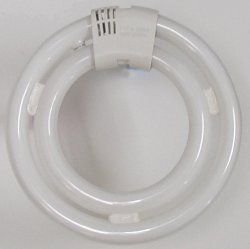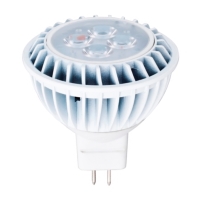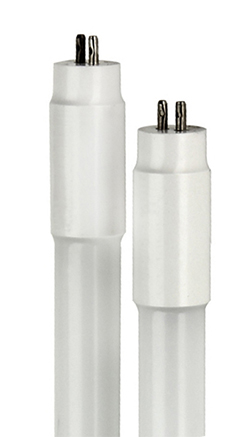This post has been updated from its original 2013 version.
These round bulbs pack a few more features than their fun design suggests, and if you are not savvy to the ways of circline lamps you may have a hard time incorporating them into your home’s lighting. To fully understand and get the best out of circular fluorescent bulbs, keep the following four facts in mind.
Pay Attention to Wattage
Just as with (the soon to be gone) standard incandescent light bulbs, circline lamps use wattages to measure how much power is used to light a bulb. By comparison, the circular fluorescent lights emit the same amount of light (lumens) while using less power than incandescents. A circline light bulb of only 13 watts can replace a 60 watt incandescent bulb and has an output of 650-900 lumens. The wattage of the bulb also determines the diameter of the bulb which in turn determines if it will fit the fixture. So unlike standard spiral CFLs you may not be able to go up or down in wattage range because it will affect the size of the bulb possibly rendering it unusable with your fixture.
Color Temperatures Are the Same as Standard CFLs
Color temperatures represent how bright a bulb is. Circular fluorescent bulbs can range in color from warm white to the brightest daylight just like standard compact fluorescent lights. Color specifics are all varying shades of white:
- 2700K: Warm, equivalent to what is typical in a bedroom or living room
- 3000-3500K: Soft, suitable for bathrooms
- 4100K: Cool, florescent-like in color
- 5000K: Daylight, the brightest color, like sunlight at noon
Circular Bulbs Cannot be Used in Just Any Fixture
This is where using a circular fluorescent can get tricky. Depending on the manufacturer, some light fixtures only use bulbs from their own line. Yeah, I know it can be tempting sometimes to go with an off/generic brand, but in this case your generic circline lamp may not work in the fixture. When replacing a Circular Lamp, first make sure that there are no manufacturer specifics determining what bulb can be used. Next, determine what the lamp type (e.g. T6 , T9) and pin type is (e.g. 2 pin, 4 pin). When finding the right lamp for your fixture, you have to choose the same lamp type and pin types as these are not interchangeable.
Diameter Matters
For light fixtures that use circular bulbs that are too big or too small will not work, even if it is from the right manufacturer. Make sure to replace these bulbs by measuring the diameter of an existing bulb then purchase the right size. If you would rather leave measuring alone, you can also use the manufacturer model number to find a replacement bulb.
While there is more to be taught and learned about circular fluorescent bulbs, these four facts alone will allow you to make informed purchases and hassle-free replacements. See, it doesn’t take much to become savvy to the ways of circline lamps.










 Traditionally, fluorescent T8 linear lamps have been used as the main light source in commercial buildings such as hospitals, warehouses, schools, and more. LED T8 lamps are quickly replacing their fluorescent counterparts. The LED technology provides higher efficiency, many color and lumen options, and sizes. Advancements in lighting capabilities have also led to more options for installation. When deciding on which lamps to replace your fluorescent T8s with, one of the main things to consider is the ballast type. Knowing the difference between a
Traditionally, fluorescent T8 linear lamps have been used as the main light source in commercial buildings such as hospitals, warehouses, schools, and more. LED T8 lamps are quickly replacing their fluorescent counterparts. The LED technology provides higher efficiency, many color and lumen options, and sizes. Advancements in lighting capabilities have also led to more options for installation. When deciding on which lamps to replace your fluorescent T8s with, one of the main things to consider is the ballast type. Knowing the difference between a  In commercial and industrial buildings, High Intensity Discharge, or HID, light fixtures are commonly found. These are high voltage fixtures that use a mix of metals and gases to create a bright and powerful white light. With each year, and as technology continues to advance, there are far more options for lighting than ever before. Among the most energy efficient options for illuminating any space are LEDs. Naturally, the larger the space, the greater the opportunity for savings. Making the switch from an HID light fixture to a
In commercial and industrial buildings, High Intensity Discharge, or HID, light fixtures are commonly found. These are high voltage fixtures that use a mix of metals and gases to create a bright and powerful white light. With each year, and as technology continues to advance, there are far more options for lighting than ever before. Among the most energy efficient options for illuminating any space are LEDs. Naturally, the larger the space, the greater the opportunity for savings. Making the switch from an HID light fixture to a 
 technical requirements for indoor and outdoor Luminaries and Retrofit Kits, and there are now two categories of designation, DLC standard and DLC premium.
technical requirements for indoor and outdoor Luminaries and Retrofit Kits, and there are now two categories of designation, DLC standard and DLC premium.